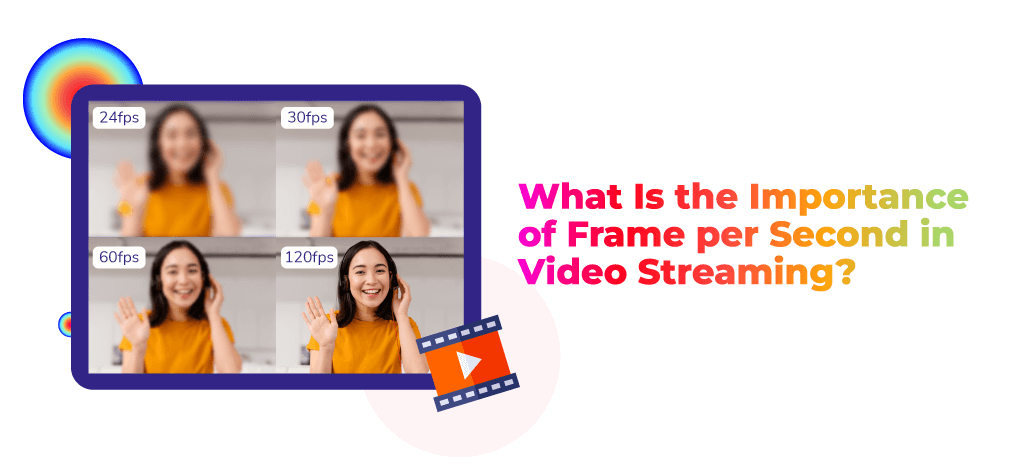Video content has become an important part of multiple industries, businesses, influencers, and broadcasters. Producing high-quality videos has become a priority to enhance the user experience. Frame per second (FPS) is an important factor to consider when streaming or broadcasting video content. Producing high-quality video requires knowledge and strategies because the right video frame rate depends on the content type and playback devices. However, the frame rate at which the video has been recorded and the frame rate it is being played may be different.
FPS and frame rate are often used interchangeably, but there is a slight difference in their characteristics. Whether talking about bitrate or pixels, many streamers believe that more is better, which is not the case. In this blog, we will discuss what is a frame per second along with its importance, values, and more.
Table of Contents
What Is Frame per Second?
FPS is a measure of how multiple individual frames or images are displayed within a second and are processed through the human eye. The higher the FPS, the smoother the video appears before the eyes. It is an important aspect to consider when video streaming, as it can elevate the audience experience. There are multiple FPS values like 24, 30, 60 etc. however a higher frame per second generally results in smoother and more realistic motion. The FPS of a video is often expressed or considered as frame rate, which has a similar meaning.
What Is the Importance of FPS, and Why Does It Matter?
The video industry has been streamlined drastically, with technical and software improvements. It has increased the importance of understanding video frame rates before shooting a video, especially when you are producing high-quality content. It also impacts the style and viewing experience of the audience by making it smooth and seamless. The frame rate for live streaming is also considered important to enhance the viewing experience, but it can differ depending on the playback devices. Here are a few more reasons why FPS is important:
Smoothness of Visuals
Having a higher FPS for your video broadcasting results in smoother motion. Many video content displays more frames per second, which makes the transition between the frames seamless and reduces stuttering. It is a crucial aspect in fast-paced scenarios like the gaming industry.
Immersive Experience
A higher video frame rate contributes to a more realistic and immersive experience, which often leads to elevated video experience. This is noticeable and important in video live streaming and video games, where smooth transitions enhance engagement in virtual environments.
Responsiveness
A suitable FPS for your video content leads to better responsiveness because the visual transactions are updated more quickly. This responsiveness through frame per second is critical for multiple industries where seamless visual experience is crucial.
Professionalism
In the video industry, whether you are live streaming, broadcasting, or creating animations, you need to show professionalism to enhance your brand image. The video frame rate can influence the impact of production and create a great impression on the audience. Different FPS values are often chosen for artistic reasons or to create specific visual effects.
Streaming and Broadcasting Quality
Higher FPS contributes to a better viewing experience when you are broadcasting or live streaming. It ensures that fast-moving actions are captured and provided with clarity and ensures a seamless experience.
Which Video Frame Rate Should Be Considered?
Most streamers or broadcasters believe that a higher frame rate means a higher video quality, but this is not true. Having too high FPS can increase the risk of unnecessary high video bitrate stream, or it can impact certain playback devices. You need to determine a few things while deciding on the video frame rate:
- Is there any action in the video?
- Is playback experience required for more cinematic?
- What is the playback device the audience will be using?
- Is there any slow-motion content?
Once determine these aspects, you can consider the following popular frame-per-second values and how they can fulfil those needs. Here are the most used FPS values that are being used:
24 FPS
This is the most commonly used value for movies and TV shows and is considered the closest we can get to experiencing action in the real world. 24 frames per second is considered the minimum speed to capture video and maintain a realistic motion and similarly provide a cinematic experience. Here are some best use cases of this video frame rate:
- Someone speaking or talking to each other
- Landscape videos
- Video content where details and texture are important
- High-resolution videos
- Live streaming events
30 FPS
This is a standard frame per second value for a standard live stream for TV in the USA. Many modern cameras can capture 30 FPS video content and make a smoother experience. This is the best frame rate and is ideal for sports and other fast-moving videos that contain action. Common use cases of using this frame rate are:
- This rate can be slowed down to 24 FPS to use
- Sports, action, and other fast-moving video content
- Cinematic shots
- Action shots
- Shots that require extra details
60 FPS
This is a high frame rate and is typically the highest frame rate for live streaming. It is frequently used in high-action video game recordings, sports, event live streaming, and for creating slow-motion footage. In most cases, it is difficult to point out the difference between 30 and 60 FPS during production. However, when this frame rate for live streaming or other video content is compressed it can contain artifacts that have lower FPS don’t have and degrades the quality. 60 FPS can be used in:
- A more graceful appearance
- For slowing down video shots during action or sports event
- Has the perfect slow-motion ability
- Fast-paced content
Factors to Consider for Video Frame Rate
It is not necessary that the FPS you have chosen will work effectively and can be captured through playback. Whether it is the frame rate for live streaming or broadcasting, it can vary from one stage to another. Here are a few more aspects to consider for your FPS setting:
Source
If you can control the video frame rate through the camera or other video source, you can match the content frame rate. For fast-moving actions consider 50/60 FPS, and for slow or moderate video content consider 25/30 FPS. High-quality 60 FPS requires more bandwidth than 30 FPS, and the audience can easily differentiate between the two qualities.
Encoder
You might want to match the source and if you don’t have sufficient bandwidth to support high-quality video content then consider cutting the frame per second in half. Another consideration is the frame rate should be accepted easily by the delivery service that is being used.
Transcoder
When you are delivering video using an adaptive bitrate streaming system, then your transcoder creates multiple outputs at different bitrates, which is called an encoding ladder. When you are working with lower bitrates, you need to reduce the FPS to show fewer frames at higher quality to ensure smoothness.
Final Thoughts
No matter if you are live streaming or broadcasting the frame per second or frame rate remains an important factor that can determine the quality of your video content. FPS is crucial to providing a high-quality and smooth experience for your audience. The video frame rate can show professionalism for your brand and create a responsive experience for the audience. Dreamcast can help you with streamlined streaming solutions from live streaming to multistreaming. Experience enhanced and tailored solutions specific to your events, book a demo now to learn more.
Connect with the Industry's Most Experienced
Live Streaming Service Providers.





















